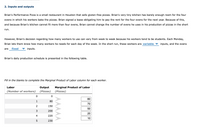
ENGR.ECONOMIC ANALYSIS
14th Edition
ISBN: 9780190931919
Author: NEWNAN
Publisher: Oxford University Press
expand_more
expand_more
format_list_bulleted
Question
I am having trouble understanding how to answer the last part of this question. I am providing the work I did on the remainder of the problem to provide context, but the multiple choice question is what I'm stuck on. If you see an error in my previous work that would cause me to have trouble with this last question, please let me know and I will fix it. Thank you!

Transcribed Image Text:2. Inputs and outputs
Brian's Performance Pizza is a small restaurant in Houston that sells gluten-free pizzas. Brian's very tiny kitchen has barely enough room for the four
ovens in which his workers bake the pizzas. Brian signed a lease obligating him to pay the rent for the four ovens for the next year. Because of this,
and because Brian's kitchen cannot fit more than four ovens, Brian cannot change the number of ovens he uses in his production of pizzas in the short
run.
However, Brian's decision regarding how many workers to use can vary from week to week because his workers tend to be students. Each Monday,
Brian lets them know how many workers he needs for each day of the week, In the short run, these workers are variable v inputs, and the ovens
are fixed
v inputs.
Brian's daily production schedule is presented in the following table.
Fill in the blanks to complete the Marginal Product of Labor column for each worker.
Labor
Output
Marginal Product of Labor
(Number of workers)
(Pizzas)
(Pizzas)
80
80
70
150
50
200
20
4
220
10
230

Transcribed Image Text:On the following graph, plot Brlan's production function using the green points (triangle symbol).
Note: Plot your points in the order in which you would like them connected. Line segments will connect the points automatically.
Hint: Be sure to plot the first point at (0, 0).
250
225
Production Funcion
200
175
150
125
100
75
50
25
4
LABOR (Number of workers)
Suppose that labor is Brian's only varlable cost and that he has a fixed cost of $15 per day and pays each of his workers $30 per day.
Use the orange points (square symbol) to plot Brian's total cost curve on the following graph using the quantities from the preceding table.
200
180
Total Cost
160
140
120
100
B0
60
40
20
25
50
75
100
125
150
175
200 225
250
QUANTITY OF OUTPUT (Pizzas)
The law of diminishing marginal product of labor is demonstrated by which of the following?
O Total output Increases only when you increase both labor and ovens.
Total output increases at a decreasing rate as you increase the quantity of labor.
O Total output declines as you Increase the quantity of labor.
TOTAL COST (Dollars)
QUANTITY OF OUTPUT (Pizzas)
Expert Solution
This question has been solved!
Explore an expertly crafted, step-by-step solution for a thorough understanding of key concepts.
Step by stepSolved in 2 steps with 1 images

Knowledge Booster
Learn more about
Need a deep-dive on the concept behind this application? Look no further. Learn more about this topic, economics and related others by exploring similar questions and additional content below.Similar questions
- The hypothesis, (as stated in the title) of E.F. Schumacher’s seminal book Small is Beautiful belongs to the industrial age and has no relevance to our contemporary Web 2.0 world. Is this statement true? Why or why not? add one reference please, between 150-200 words onlyarrow_forwardCould you specifically explain question (b), such as the process in detail and how you got the correct solutionarrow_forwardExplain what is meant by “contribution analysis”. Carefully define the term and provide examples to illustrate it.arrow_forward
- The first step to take when you consider making a major purchase is to decide (a) whether you need the product (b) whether you have enough money to buy the product (c) what make and model of the product you should buy (d) where the best place is to purchase the product.arrow_forwardWhat is aresource? the result of choices made by business firms the result of scarcity in the economic system anything people use to make or obtain what they need or want a physical object that can be purchasedarrow_forward
arrow_back_ios
arrow_forward_ios
Recommended textbooks for you

 Principles of Economics (12th Edition)EconomicsISBN:9780134078779Author:Karl E. Case, Ray C. Fair, Sharon E. OsterPublisher:PEARSON
Principles of Economics (12th Edition)EconomicsISBN:9780134078779Author:Karl E. Case, Ray C. Fair, Sharon E. OsterPublisher:PEARSON Engineering Economy (17th Edition)EconomicsISBN:9780134870069Author:William G. Sullivan, Elin M. Wicks, C. Patrick KoellingPublisher:PEARSON
Engineering Economy (17th Edition)EconomicsISBN:9780134870069Author:William G. Sullivan, Elin M. Wicks, C. Patrick KoellingPublisher:PEARSON Principles of Economics (MindTap Course List)EconomicsISBN:9781305585126Author:N. Gregory MankiwPublisher:Cengage Learning
Principles of Economics (MindTap Course List)EconomicsISBN:9781305585126Author:N. Gregory MankiwPublisher:Cengage Learning Managerial Economics: A Problem Solving ApproachEconomicsISBN:9781337106665Author:Luke M. Froeb, Brian T. McCann, Michael R. Ward, Mike ShorPublisher:Cengage Learning
Managerial Economics: A Problem Solving ApproachEconomicsISBN:9781337106665Author:Luke M. Froeb, Brian T. McCann, Michael R. Ward, Mike ShorPublisher:Cengage Learning Managerial Economics & Business Strategy (Mcgraw-...EconomicsISBN:9781259290619Author:Michael Baye, Jeff PrincePublisher:McGraw-Hill Education
Managerial Economics & Business Strategy (Mcgraw-...EconomicsISBN:9781259290619Author:Michael Baye, Jeff PrincePublisher:McGraw-Hill Education


Principles of Economics (12th Edition)
Economics
ISBN:9780134078779
Author:Karl E. Case, Ray C. Fair, Sharon E. Oster
Publisher:PEARSON

Engineering Economy (17th Edition)
Economics
ISBN:9780134870069
Author:William G. Sullivan, Elin M. Wicks, C. Patrick Koelling
Publisher:PEARSON

Principles of Economics (MindTap Course List)
Economics
ISBN:9781305585126
Author:N. Gregory Mankiw
Publisher:Cengage Learning

Managerial Economics: A Problem Solving Approach
Economics
ISBN:9781337106665
Author:Luke M. Froeb, Brian T. McCann, Michael R. Ward, Mike Shor
Publisher:Cengage Learning

Managerial Economics & Business Strategy (Mcgraw-...
Economics
ISBN:9781259290619
Author:Michael Baye, Jeff Prince
Publisher:McGraw-Hill Education